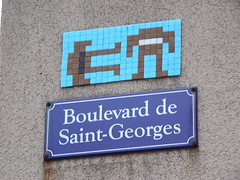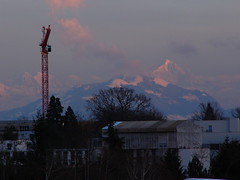Tuesday, February 28, 2006
Robot Wars, Geneva
Tuesday, February 21, 2006
ATLAS & Me
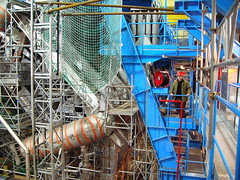 These days, it's not a trip to CERN without a tour in the ATLAS pit. My colleague Pavel snapped this photo of me standing on the scaffolding next to a tiny fraction of the ATLAS detector, which is currently under feverish construction in advance of the LHC start-up, still planned for end-2007.
These days, it's not a trip to CERN without a tour in the ATLAS pit. My colleague Pavel snapped this photo of me standing on the scaffolding next to a tiny fraction of the ATLAS detector, which is currently under feverish construction in advance of the LHC start-up, still planned for end-2007.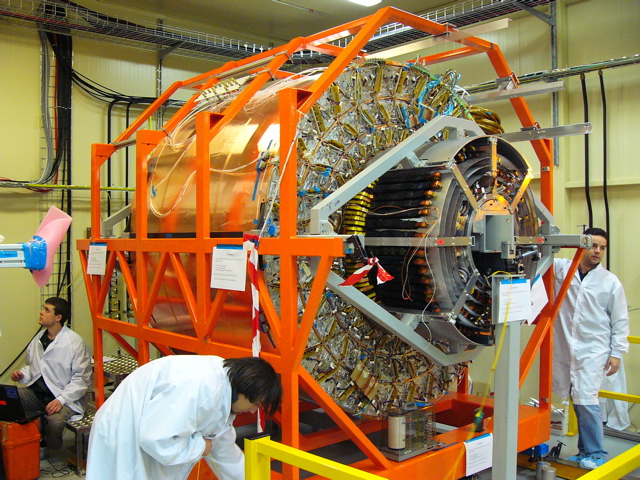 Needless to say, this thing is big. BIG. But what I still find fascinating is that while the muon system is enormous, and the calorimeters are huge, the "inner detector" which tracks particles in a profoundly complicated silicon and straw-tube detector is much more human-sized. My old colleague Heinz took me to their assembly room where they were surveying the recently-assembled "barrel". Much smaller, but a sublime piece of work with the millions of channels we will be using to study nucleus-nucleus collisions at the LHC.
Needless to say, this thing is big. BIG. But what I still find fascinating is that while the muon system is enormous, and the calorimeters are huge, the "inner detector" which tracks particles in a profoundly complicated silicon and straw-tube detector is much more human-sized. My old colleague Heinz took me to their assembly room where they were surveying the recently-assembled "barrel". Much smaller, but a sublime piece of work with the millions of channels we will be using to study nucleus-nucleus collisions at the LHC.
Mont Blanc, Revealed
I should mention, however, that I have not seen Mont Blanc from the CERN site since my student days in the mid 90's. It's usually been cloudy during my short visits here. The only way to really guarantee a good view is to head southeast by car. Give me a few days...
Friday, February 17, 2006
Who's the Scientist?

 This is the greatest thing I've seen in a while. A group of 7th graders visited Fermilab and made before-and-after descriptions and drawings of their image of scientists.
This is the greatest thing I've seen in a while. A group of 7th graders visited Fermilab and made before-and-after descriptions and drawings of their image of scientists.This is real progress, folks.
(Thanks, Betsy!)
Wednesday, February 15, 2006
Richard and Me
 This has been in the works quite a while, but is only now reaching the web. In October, I did an interview with Carolyn Weaver of Voice of America TV about RHIC, it's science, and the controversies surrounding the various "doomsday" scenarios proposed in the 80's and 90's. It's now posted on the VOA website.
This has been in the works quite a while, but is only now reaching the web. In October, I did an interview with Carolyn Weaver of Voice of America TV about RHIC, it's science, and the controversies surrounding the various "doomsday" scenarios proposed in the 80's and 90's. It's now posted on the VOA website.What I hadn't realized when I agreed to give this interview was that Weaver had already spoken to Richard Posner, the eminent federal judge. Posner wrote a book in 2004, "Catastrophe: Risk and Response", which discusses the risks of RHIC, among other disasters, and how we are currently not dealing with various eventualities. And here in the final product (shown to the right), I find myself superimposed on Posner, if only for a brief instant. How many of my lawyer friends can say that?
I've discussed Posner and other critics various times in my previous blog, and I maintain that I find their arguments still less than compelling in their particulars. But I never imagined I'd get a chance to say so in public. I still believe that while we should take risks seriously, and in general scientists should be held accountable for the risks they take, and discuss them openly. However, we must constantly be updating the level of risk based on incoming information. Posner (and Rees, for that matter) are basing everything on several papers written in 1999 and before, well before the RHIC data came in. Since that time, we have found that the matter we create at RHIC essentially blows apart as soon as it is made. And more importantly, this matter is not baryon rich, as it was at the AGS. This suggests to me that we're even less likely to make stable strange matter than ever before. That said, I should not be construed to be a real expert on this subject. But that said, no expert I know has suggested that the risk level has increased. There have even been searches for strangelets at RHIC (in the baryon-rich forward region) which have (as always) come up empty!
So until my colleagues A) actually isolate even a hint of a strangelet signal, and B) start to believe (based on experimental data) that RHIC is really a better enviroment for their production than previous facilities (which have established stringent upper limits), I think it's premature to start any serious discussions of the risk of RHIC to humanity as a whole. But I'm sure someone out there already disagrees with me.
Friday, February 10, 2006
Budget Watch, contd., and the Future
The AAAS released an analysis of the budget here, with a choice quote:
The Department of Energy (DOE) would enjoy substantial increases for its energy and science R&D portfolios in 2007, an unusual turn of events for a department that has mostly seen flat budgets in recent years (see Figure 6). The DOE Office of Science (OS) would emerge as the clear winner in the 2007 budget with a 14 percent increase to $3.8 billion for its R&D portfolio centered around the physical sciences. The largest OS programs would all receive increases of 8 percent or more, including a dramatic 24 percent boost for Nuclear Physics after a decade of stagnant funding, a 36 percent increase for computing research, a 25 percent increase for Basic Energy Sciences centered around several large-scale facilities, and a 31 percent increase for the core life sciences research portfolio. Although these increases would help BES, computing research, and nuclear physics reach new highs, high-energy physics, fusion, and biological and environmental research would remain below previous years’ funding levels because of years of eroding budgets.What a rollercoaster, from the World Year of Physics presenting us with the worst budget in a while, with many gloom-and-doom predictions for the future, to an enormous "bounce" (hope not a "dead-cat" bounce...) and a rosy outlook. But people should keep in mind that a 24% increase relative to 2006 doesn't translate into a huge increase if one averages over the last few years: it's only 15% above the 2005 budget, and inflation depreciates all funding by 3-4% a year, so it's really equivalent to a real 8% increase -- not peanuts to be sure, but it certainly does not sound as whopping as 24%!
This was echoed today by a short presentation by Directory Chaudhari presenting how the budget will directly affect BNL. He reported the robust RHIC budget, promising a 34 week run (not 30 as I mentioned previously), funding for RHIC II-related work (i.e. EBIS, the new ion source), R&D funding for NSLS II (which will be another major facility here, with QCDLab, if it gets sited here) and full funding of the Center for Functional Nanomaterials. All good news, but not nearly as striking as the projections for the lab's future, predicated on these increases. If all goes well, the general shrinking of personnel and near-constant funding levels over the last 5 years will reverse over the next 4-5 years, with the lab's funding increasing by 40% and employment increasing by over 10% over the next five years. Amazing prospects.
Wednesday, February 08, 2006
Justice for RHIC
 So after all of the struggles last year (remember the 65% solution?), things are certainly looking up this year. Newsday (and never the New York Times, it seems!) has a piece (and a photo of STAR, with my colleague Gene Van Buren in front!) which seems to have run twice in the last couple of days: "Proposal lets collider run a full schedule".
So after all of the struggles last year (remember the 65% solution?), things are certainly looking up this year. Newsday (and never the New York Times, it seems!) has a piece (and a photo of STAR, with my colleague Gene Van Buren in front!) which seems to have run twice in the last couple of days: "Proposal lets collider run a full schedule". The relativistic heavy ion collider received $121.5 million for 32 weeks of operation in fiscal 2005, but this year had its budget cut to $110 million. After a $13 million private donation, the collider is scheduled for 20 weeks of operation this year. The proposed 2007 budget includes $138 million for a full schedule of 30 weeks of operation.This sounds a little awkward, getting more money for less running, but people should realize that we have massive R&D needs, and major upgrades are underway, both for the big detectors (STAR and PHENIX) and for the accelerator (Uranium, anyone?)
But while I appreciate Newsday's interest quite a bit, I wish they would just stop saying this:
The collider is a superconductor that accelerates ions to nearly the speed of light, allowing scientists to explore the smallest known pieces of matterIt's an accelerator, not a superconductor! Yes, there are superconducting magnets everywhere, but ultimately the particles are accelerated in vacuum and just guided by the magnets. Yes it sounds niggly, but I don't think our material science friends would appreciate the confusion either.
Friday, February 03, 2006
Freedom from Justice?
 Just a short follow-up to that last post. I arrived for day 2 of Jury Duty at 10am, and essentially did nothing for the rest of the day, only to be fully discharged by 3:30pm, after a two hour lunch break. I was happy to do my duty, in principle, but it still makes me a bit sad that having an overly-developed sense of the objective, and thus a high standard for evidence, makes me a liability to the legal system as it is.
Just a short follow-up to that last post. I arrived for day 2 of Jury Duty at 10am, and essentially did nothing for the rest of the day, only to be fully discharged by 3:30pm, after a two hour lunch break. I was happy to do my duty, in principle, but it still makes me a bit sad that having an overly-developed sense of the objective, and thus a high standard for evidence, makes me a liability to the legal system as it is. So I guess the scales of justice aren't for me, despite the obvious point that they borrow their defining trope from the scientific method. Clearly, the whole concept of showing the scales of justice is to indicate an objective "measuring" the guilt of the defendant by recourse to brute facts. Go figure: maybe that's why lady justice is portrayed as blind?
Wednesday, February 01, 2006
Law and Physics
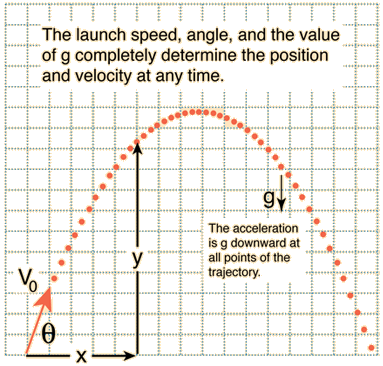 After the mayhem of last week, spending 8+ hours a day with ATLAS software, this week has taken on a whole new character: Jury Duty. After holding off the New York Supreme Court for a few months back in the autumn, I was finally compelled to drop by the courthouse this morning. I can't give much in the way of details, but I can report a few things that surprised me.
After the mayhem of last week, spending 8+ hours a day with ATLAS software, this week has taken on a whole new character: Jury Duty. After holding off the New York Supreme Court for a few months back in the autumn, I was finally compelled to drop by the courthouse this morning. I can't give much in the way of details, but I can report a few things that surprised me.Jury duty takes a lot less time than it used to: apparently it was two weeks, only a few years ago, but it's certainly never going to end after a day. Minimum is two days, and it's looking like typical cases can take days. Consider that next time you pick your next postponement date. The orientation is cheesy, the time lost from work is a little excessive, but after a while you really start to get into it. While it really looks like a hardship in the abstract, seeing a few details of how the legal system works is pretty neat. Heck, I'm a physicist: I like to know how things work, and the law is supposed to be a machine of sorts, right? Based on laws, just like physics, right?
Well maybe, but they certainly don't seem to value the scientific outlook. While I really can't say much about what went on the courtroom, I can say that I was in the first (large) group of people to be brought down to be considered for a jury. I can also say that I was in the first group of 12 to be considered out of the larger group. So for a few minutes I felt kind of proud of myself, that I could serve my civic duty. Then the questions began, as we cycled through our renditions of the "Voir Dire", a set of questions related to our ability to serve impartially on the jury. Have you ever been a victim of a crime? Do you know anyone in law enforcement? And so on. Most of us didn't set off any alarms in this way, as few people are so scarred by their experiences with courts or law enforcement that they can't consider a situation objectively.
Then they asked us what we did for a living and where we went to school. At first I didn't understand why, although it was fascinating to see the wide cross section of people they had selected, from a wide range of backgrounds and occupations. But a funny thing happened as soon as I said: "Physicist, PhD, MIT". "So you want to be an astronaut?" asked the New York Supreme Court Judge. That started to make me suspicious. Then the prosecuting DA asked: "Mr. Steinberg, scientists typically want objective means to verify facts. Do you think you will be able to believe testimony given by witnesses in the case?" I had to think about this one: "I would feel responsible to my duty to the court, but I really prefer to have some objective verification of facts I am given." I thought this seemed reasonable, to express a high standard for evidence. But the judge lit into me: "You scientists want all the answers! One has to be able to find a defendant guilty on the testimony of a single witness. It's not about the quantity, but the quality!" I realize that this has to be the case, for the system to convict anyone, but I've always been taught to verify everything, since even the smartest, most reliable, people can make mistakes in their perceptions or interpretations.
The defense attorney picked up on my response, however, in a way that made me very suspicious. After he asked me a few questions of what kind of physics I do ("nuclear physics? that's my favorite!" said the judge), he extended this issue of questioning testimony: "I hope all of you will be able to consider that a story given by a witness could be a lie." Always a possibility, but at that point I started to wonder if I was a goner. And after a short recess I was a goner, along with six others in my group, sent back to the pool of potential jurors. Although it wasn't the only reason to cut someone from a jury, the very training I was so proud of, the one that made me so sensitive to various issues in how we know what we know, made me essentially unqualified to serve in one of our most important civic institutions.
So while there are clearly laws of physics, there doesn't seem to be much room for physics in the law. Hasn't anyone seen Minority Report? Better luck tomorrow!

